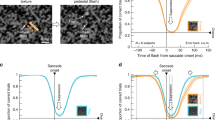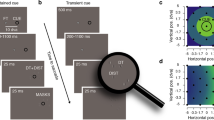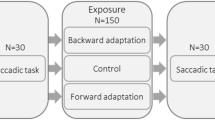Abstract
To make a saccadic eye movement to a target we must first attend to it. It is therefore not surprising that diverting attention increases saccade latency, but is latency increased in all cases? We show that attending to a peripheral discrimination task has a paradoxical effect. If the stimulus to be attended appears shortly (100 to 300 ms) before an eye movement is made in a direction opposite to that of a presented stimulus (an antisaccade), its latency is reduced to well below baseline performance. In contrast, latencies for saccades toward the stimulus (prosaccades) are increased under similar conditions. This paradoxical effect may arise from competition between the processes mediating prosaccades and antisaccades. When the discrimination task is presented at the critical moment, it interferes with a reflexive prosaccade, allowing faster antisaccades. The results suggest that the suppression of sensorimotor reflexes can facilitate volitional motor acts.
This is a preview of subscription content, access via your institution
Access options
Subscribe to this journal
Receive 12 print issues and online access
$209.00 per year
only $17.42 per issue
Buy this article
- Purchase on Springer Link
- Instant access to full article PDF
Prices may be subject to local taxes which are calculated during checkout





Similar content being viewed by others
References
Hallett, P. E. & Adams, B. D. The predictability of saccadic latency in a novel voluntary oculomotor task. Vision Res. 20, 329–339 (1980).
Everling, S. & Fischer, B. The antisaccade: a review of basic research and clinical studies. Neuropsychologia 36, 885–899 (1998).
Amador, N., Schlag-Rey, M. & Schlag, J. Primate antisaccades. I. Behavioral characteristics. J. Neurophysiol. 80, 1775–1786 (1998).
Funahashi, S., Chaffee, M. V. & Goldman-Rakic, P. S. Prefrontal neural activity in rhesus monkeys performing a delayed antisaccade task. Nature 365, 753–756 (1993).
Schlag-Rey, M., Amador, N., Sanchez, H. & Schlag, J. Antisaccade performance predicted by neuronal activity in the supplementary eye field. Nature 390, 398–401 (1997).
Forbes, K. & Klein, R. M. The magnitude of the fixation offset effect with endogenously and exogenously controlled saccades. J. Cogn. Neurosci. 8, 344–352 (1996).
Everling, S., Dorris, M. C. & Munoz, D. P. Reflex suppression in the anti-saccade task is dependent on prestimulus neural processes. J. Neurophysiol. 80, 1584–1589 (1998).
Hoffman, J. E. & Subramaniam, B. The role of visual attention in saccadic eye movements. Percept. Psychophys. 57, 787–795 (1995).
Kowler, E., Anderson, E., Dosher B. & Blaser, E. The role of attention in the programming of saccades. Vision Res. 35, 1897–1916 (1995).
Deubel, H. & Schneider, W. X. Saccade target selection and object recognition: evidence for a common attentional mechanism. Vision Res. 36, 1827–1837 (1996).
Kustov, A. A. & Robinson, D. L. Shared neural control of attentional shifts and eye movements. Nature 384, 74–77 (1996).
Broadbent, D. Successive responses to simultaneous stimuli. Q. J. Exp. Psychol. 8, 145–152 (1956).
Posner, M. I. & Boies, S. J. Components of attention. Psychol. Rev. 78, 391–408 (1971).
Greenwald, A. G. & Shulman, H. G. On doing two things at once: II. Elimination of the psychological refractory period effect. J. Exp. Psychol. 101, 70–76 (1973).
Norman, D. A. & Bobrow, D. G. On data limited and resource limited processes. Cognit. Psychol. 7, 44–64 (1975).
Joseph, J. S., Chun, M. M. & Nakayama, K. Attentional requirements in a 'preattentive' feature search task. Nature 387, 805–807 (1997).
Duncan, J., Martens, S. & Ward, R. Restricted attentional capacity within but not between sensory modalities. Nature 387, 808–810 (1997).
Pashler, H. & Johnston, J. C. in Attention (ed. H. Pashler) 155–189 (Psychology, Hove, UK, 1998).
Hoffman, J. E. in Attention (ed. H. Pashler) 119–153 (Psychology, Hove, UK, 1998).
Yantis, S. Stimulus-driven attentional capture and attentional control settings. J. Exp. Psychol. Hum. Percept. Perform. 19, 676–681 (1993).
Theeuwes, J. Stimulus-driven capture and attentional set: selective search for color and visual abrupt onsets. J. Exp. Psychol. Hum. Percept. Perform. 20, 799–806 (1994).
Bacon, W. F. & Egeth, H. E. Overriding stimulus-driven attentional capture. Percept. Psychophys. 56, 485–496 (1994).
Folk, C. L. & Remington, R. Can new objects override attentional control settings? Percept. Psychophys. 61, 727–739 (1999).
Kristjánsson, Á., Mackeben, M. & Nakayama, K. Rapid learning in the deployment of transient attention. Perception (in press).
Ross, L. E. & Ross, S. M. Saccade latency and warning signals: stimulus onset, offset, and change as warning events. Percept. Psychophys. 27, 251–257 (1980).
Fischer, B. & Weber, H. Express saccades and visual attention. Behav. Brain Sci. 16, 553–610 (1993).
Neisser, U. Cognitive Psychology (Appleton-Century-Crofts, New York, 1967).
Pashler, H., Carrier, M. & Hoffman, J. Saccadic eye movements and dual-task interference. Q. J. Exp. Psychol. A 46, 51–82 (1993).
Stuyven, E., Van der Goten, K., Vandierendonck, A., Claeys, K. & Crevits, L. The effect of cognitive load on saccadic eye movements. Acta Psychol. 104, 69–85 (2000).
Duncan, J., Humphreys, G. & Ward, R. Competitive brain activity in visual attention. Curr. Opin. Neurobiol. 7, 255–261 (1997).
Goldberg, M. E. in Principles of Neural Science 4th edn. (eds. Kandel, E., Schwartz, J. H. & Jessel, T. M.) 782–800 (McGraw-Hill, New York, 2000).
Sparks, D. L. & Barton, E. J. Neural control of saccadic eye movements. Curr. Opin. Neurobiol. 3, 966–972 (1993).
Schall, J. D. & Thompson, K. G. Neural selection and control of visually guided eye movements. Annu. Rev. Neurosci. 22, 241–259 (1999).
Dorris, M. C., Pare, M. & Munoz, D. P. Neuronal activity in monkey superior colliculus related to the initiation of saccadic eye movements. J. Neurosci. 17, 8566–8579 (1997).
Goldberg, M. E. & Bushnell, M. C. Behavioral enhancement of visual responses in monkey cerebral cortex. II. Modulation in frontal eye fields specifically related to saccades. J. Neurophysiol. 46, 773–787 (1981).
Guitton, D., Buchtel, H. A. & Douglas, R. M. Frontal lobe lesions in man cause difficulties in suppressing reflexive glances and in generating goal-directed saccades. Exp. Brain. Res. 58, 455–472 (1985).
Schiller, P. H., Sandell, J. H. & Maunsell, J. H. The effect of frontal eye field and superior colliculus lesions on saccadic latencies in the rhesus monkey. J. Neurophysiol. 57, 1033–1049 (1987).
Chen, L. L. & Wise, S. P. Neuronal activity in the supplementary eye field during acquisition of conditional oculomotor associations. J. Physiol. (Lond.) 73, 1101–1121 (1995).
Bruce, C. J. & Goldberg, M.E. Primate frontal eye fields. I. Single neurons discharging before saccades. J. Neurophysiol. 53, 603–635 (1985).
Schall, J. D. Neuronal activity related to visually guided saccades in the frontal eye fields of rhesus monkeys: comparison with supplementary eye fields. J. Neurophysiol. 66, 559–579 (1991).
Everling, S. & Munoz, D. P. Neuronal correlates for preparatory set associated with pro-saccades and anti-saccades in the primate frontal eye field. J. Neurosci. 20, 387–400 (2000).
Everling, S., Dorris, M. C., Klein, R. M. & Munoz, D. P. Role of primate superior colliculus in preparation and execution of anti-saccades and pro-saccades. J. Neurosci. 19, 2740–2754 (1999).
Acknowledgements
The research was supported by a Fulbright graduate award and a Thor Thors graduate award to A.K., an NIH grant to Y.C. and an AFOSR grant to K.N. We thank J. Edelman, C. Stromeyer and P. Cavanagh for comments.
Author information
Authors and Affiliations
Corresponding author
Rights and permissions
About this article
Cite this article
Kristjánsson, Á., Chen, Y. & Nakayama, K. Less attention is more in the preparation of antisaccades, but not prosaccades. Nat Neurosci 4, 1037–1042 (2001). https://doi.org/10.1038/nn723
Received:
Accepted:
Published:
Issue Date:
DOI: https://doi.org/10.1038/nn723
This article is cited by
-
Effects of saccade training on express saccade proportions, saccade latencies, and peak velocities: an investigation of nasal/temporal differences
Experimental Brain Research (2018)
-
Arousal facilitates involuntary eye movements
Experimental Brain Research (2016)
-
Violating the main sequence: asymmetries in saccadic peak velocities for saccades into the temporal versus nasal hemifields
Experimental Brain Research (2013)
-
Saccade performance in the nasal and temporal hemifields
Experimental Brain Research (2012)
-
Is the relationship of prosaccade reaction times and antisaccade errors mediated by working memory?
Experimental Brain Research (2011)



